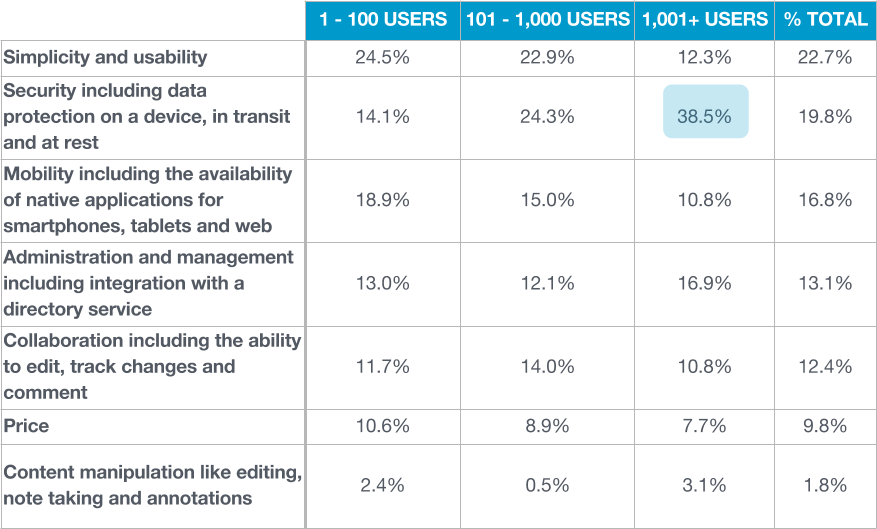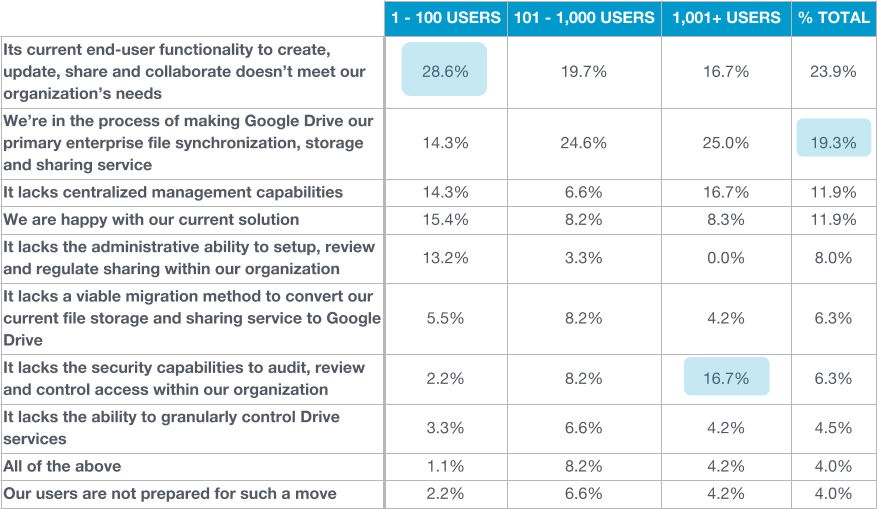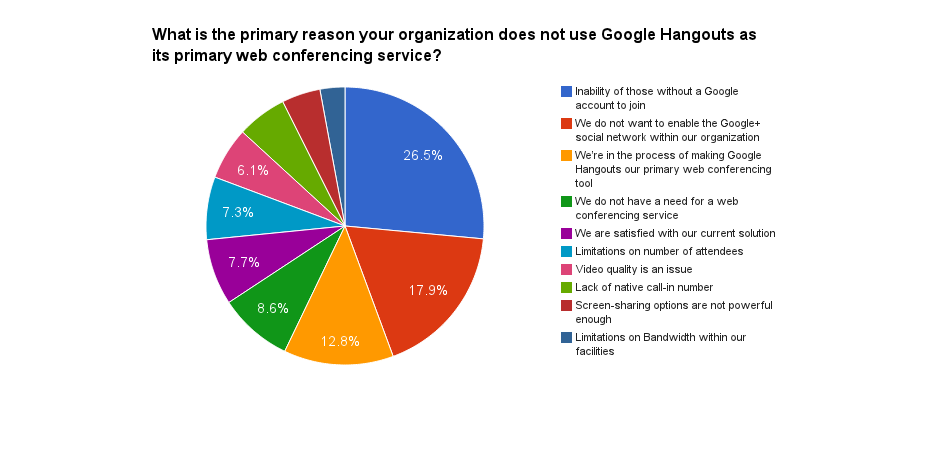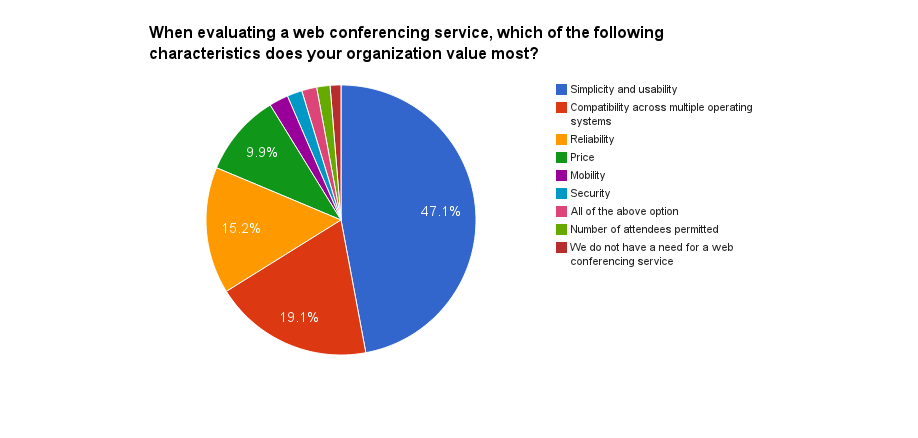Google Apps Survey: Why Platform Offerings Will Win, Google's Relationship with the Ecosystem and an Emerging Battle Between Google Apps and Office 365
October 29, 2014
16 minute read
We recently surveyed thousands of Google Apps administrators around the world to gain valuable feedback and insights not only on our product, FlashPanel, but also on the adoption of Google Apps, specifically in the contexts of directory services (Google Apps Directory versus legacy systems like Active Directory), Google Drive versus non-native enterprise file synchronization, storage and sharing services (EFSSS) and Google Hangouts versus other web conferencing platforms.
We’ve deliberately pinpointed these three areas as each seems to be of increasing importance to Google as seen with the recent launch of Drive for Work, the uncoupling of Google+ and Hangouts and feedback from customers who no longer rely on legacy directory systems.
One main theme emerged throughout the survey revealing Google’s new role as a true platform player and the efficacy and inevitable success of platforms over standalone offerings. As Google continues to build out Apps’ functionality, ultimately eclipsing the sophistication of standalone products like Dropbox and GoToMeeting, the suite will be unstoppable. As a customer looking to make changes to their IT infrastructure, being able to invest in a single deeply integrated platform that can scale infinitely and comes at a great price is the logical and ultimately best use of IT’s time and budget.
It is our hope that the data and insights herein will give readers a line of sight into Google’s enterprise strategy as well as a means of understanding how customers, resellers and solution providers have and should react to past and forthcoming changes.
Survey Highlights
- 42.2% of all respondents note their organization currently uses the Google Apps Directory and replacing legacy directory systems like Active Directory with Google’s offering is key to moving companies entirely to the Apps Platform.
- Nearly 80% of all respondents actively use Google Drive. For small companies now on Drive, many transitioned from Dropbox while larger organizations came from EMC and legacy file shares. For broader adoption of Drive to occur, particularly in the enterprise size segment, additional security controls, like those provided by FlashPanel – including sharing policies, in-depth reporting, and DLP and PCI compliance – are needed.
- Almost 60% of all respondents use Google Hangouts as their organization’s primary web conferencing service. And Google’s move to decouple Google+ and Hangouts is a huge boon for continued adoption.
- Google Apps resellers positively impact the adoption of Google Apps services like Drive and Hangouts. Despite increased use of Google services, survey respondents would still like more communication and better support from their resellers.
Survey Respondent Demographics
This survey looks at data taken from 1,014 respondents. Of these respondents, 764 represent businesses, while the remaining 250 represent educational institutions.
To gain more information about our respondents’ backgrounds and experience with various technology, we asked:
Not surprisingly, the majority came from Microsoft Exchange. With that being said, when we looked at this question broken down by organization size, it was clear that many smaller organizations get started on and stay with Google Apps. It will be interesting to see how these trends change as Microsoft works to make the move from Exchange to Office 365 more seamless, while Google works to gain even broader market adoption and continues improves its overall reputation with organizations of all sizes.
Directory Services
As noted above, Microsoft Exchange was and, outside of our customer base, is still a widely used mail server, and Active Directory, Microsoft’s directory offering, goes hand in hand with Exchange. It’s also no secret that Active Directory is one of Microsoft’s strongest and most lasting holds on customers regardless of the other systems they’re using. It is difficult to deprecate Active Directory, but doing so is oftentimes the final step of moving an organization’s entire IT infrastructure to Google Apps.
While survey findings did in fact show that companies are embracing the Google Apps Directory and replacing legacy systems, more often than not, these companies are typically smaller in size. And, many companies surveyed, almost half, still rely on Active Directory.
Which directory system does your organization use?
We then asked companies using the Google Apps Directory to tell us why:
To unify everything under Google
INDUSTRY: FACILITY MANAGEMENT | 29 USERSPrevious was a “Hodge-Podge” nightmare, built out and customized based upon legacy requests and needs, with little long-term planning or assessment. Within the last year, new management has worked hard to shift many of our systems / services from in-house to outside providers, ultimately bolstering our productivity, security, etc.
INDUSTRY: NON-PROFIT | 263 USERSNew world order…want modular design…AD hooks were too deep
INDUSTRY: PHARMACEUTICALS | 309 USERSWe wanted all of our contact information in the same place as our email.
INDUSTRY: TRUCKING | 247 USERS
And lastly, we asked all respondents who are not already using the Google Apps Directory:
Would your organization ever make the Google Apps Directory your directory system?
From our data, we can gather that on the whole, smaller organizations are more willing to at least consider moving to the Google Apps Directory than their larger counterparts. But, it is compelling nonetheless to see that organizations of all sizes have left and more are willing to leave what might likely be their company’s last remaining anchor in the legacy IT world. Following up with respondents after the survey, we learned that many of our customers have outside systems, devices and processes that still rely heavily Active Directory.
When asked why they are either moving to the Google Apps Directory or considering moving, we received the following feedback:
We want to eliminate the need for onsite servers.
INDUSTRY: RECRUITING | 10 USERSIn order to consolidate everything under one system and log in.
INDUSTRY: TECHNOLOGY | 89 USERSWe are moving everything to the cloud.
INDUSTRY: NON-PROFIT | 241 USERSWe wanted to reduce our onsite infrastructure.
INDUSTRY: EDU | 241 USERSMost of our core apps are cloud based so moving to the Google Apps Directory means there will be fewer headaches when managing users in Google and FlashPanel.
INDUSTRY: FACILITIES MANAGEMENT | 400 USERSDon’t like: having to pay Microsoft licensing costs, support AD servers. Need of a SSO solution.
INDUSTRY: MEDIA | 591 USERSAll of our services are tied into Google Apps
INDUSTRY: EDU | 83 USERSSimplicity, integration, phasing out of Lotus Notes
INDUSTRY: NON-PROFIT | 250 USERSOur goal is to use a directory system that allows us to completely manage laptops from the cloud, so we can either ship brand new laptops directly to our staff, or remotely wipe and re-issue laptops without having the need for them to be sent back to our central office.
INDUSTRY: NON-PROFIT | 41 USERS
And when asked why they weren’t considering making the Google Apps Directory their organization’s directory system, we heard:
Due to the dependencies of other applications compatible for MS Active Directory
INDUSTRY: CLOUD SERVICES | 10 USERSWe have various integrations with Workday
INDUSTRY: CLOUD SERVICES | 1,100 USERSWe are still utilizing SharePoint on premises.
INDUSTRY: HEALTHCARE | 1,340 USERSDue to the ties with other applications into AD.
INDUSTRY: MANUFACTURING | 158 USERSLack of information on the integration and how it’s compared to AD.
INDUSTRY: NON-PROFIT | 342 USERSWe need to keep our directory within our infrastructure as it ties to systems behind our firewall.
INDUSTRY: RESEARCH | 1,864 USERSOther services tie into AD and LDAP, so for now, it’s not a choice.
INDUSTRY: INTERNET | 308 USERSWe are heavily invested in the Windows infrastructure in our network.
INDUSTRY: EDU | 296 USERSGPOs ad nested groups don’t work with Google Apps and we have other products pointing to AD from outside like Stoneware, MBC and Schoolwires.
INDUSTRY: EDU | 25,686 USERS
Key Takeaways:
While organization size certainly plays a role in whether or not a company has already or is willing to replace their legacy directory system with the Google Apps Directory, it’s important to focus on the fact that there is willingness overall to do so. However, the actual move won’t take place en masse until Google puts more support behind third-party vendors that provide valuable management tools which enhance the Google Apps Directory’s existing functionality, putting it on par with the functionality offered by legacy systems.
Enterprise File Synchronization, Storage and Sharing Services
For anyone who follows the transformation of Google Apps, it’s clear that Google has invested heavily in Drive over the last year. This investment culminated with the launch of Drive for Work this past summer, which gives companies the ability to upgrade to a premium, unlimited version of the cloud storage and collaboration tool. The move was seen by many as a way to compete and in some ways stay ahead of offerings from Box and Dropbox, which have maintained a strong hold on corporate users despite their standalone nature.
In addition to Box and Dropbox, we also found from our survey that many respondents are still relying on legacy file servers. However, it’s clear that more and more companies – especially SMB and mid-market – are expanding efforts to deprecate these on-premises systems and transition completely to Drive.
Drive is certainly the most popular EFSSS service among those surveyed (after all these are Google Apps customers who should take advantage of the full suite), but Dropbox and Box are also commonly used.
To find out specifically why certain companies implemented Drive, we asked:
Why does your organization use Google Drive as its primary enterprise file synchronization, storage and sharing service?
We use Google for everything else so it makes sense. Google Drive is easy for our users to use and simple for admins to monitor.
INDUSTRY: INTERNET | 981 USERSBetter sharing options, constantly updating, unlimited storage, available, multi-device compatible, the list goes on…
INDUSTRY: MEDIA | 8,649 USERSIt is part of our Google Apps implementation and, through FlashPanel, has some central administration capacity.
INDUSTRY: EDU | 241 USERSIt’s very easy to use, great tutorial videos, and I like the control setting allowing an admin to prohibit sharing outside of our organization.
INDUSTRY: EDU | 95 USERS
Added Controls are Needed to Make Drive Mainstream
As companies grow, their use of Drive, Box and Dropbox decreases overall and the use of more traditional enterprise-grade tools like EMC and on-premises file servers increases. This can likely be attributed to a lack of enterprise controls found within the aforementioned cloud solutions.
When asked what factors they value most when evaluating an EFSSS service, larger companies rated security as paramount. Usability also seems less important as company size grows.
When evaluating an enterprise file synchronization, storage and sharing service, which of the following characteristics does your organization value most?
With their current messaging and functionality, Google is definitely catering to its SMB customers. And from our data it is clear that large enterprises have still not fully bought into the Google story, which leaves room for third-party developers like BetterCloud to step in and focus on delivering the controls enterprises need, particularly around storage and collaboration. These needs, covered by our product FlashPanel, typically range from granular controls and policies around what types of documents can be shared with whom and how, in-depth reporting on publicly exposed documents, the ability to view the contents of a document through regular expression policies and more.
From our survey data, we see that larger companies require more enterprise-level controls before they are able to adopt Google Drive. But, this isn’t a phenomenon unique to Google. Enterprises have long relied on third-party vendors to bolster capabilities of native software suites – be they on-premises or in the cloud.
When asked ‘What is the main reason your organization does not use Google Drive as its primary enterprise file synchronization, storage and sharing service?’again, survey data tells us that larger organizations are in need of enhanced security capabilities around Drive like auditing and the ability to better review and control access within their organizations. Smaller companies find that the current end-user functionality does not suit their needs.
While there are certainly shortcomings with Drive’s current functionality, it is promising to note that nearly 20% of all respondents do plan to make Drive their organization’s primary EFSSS service.
When Drive Wins
As seen above, there is indeed broad adoption of Drive – particularly among smaller organizations – and a willingness by companies of all sizes to adopt the service in the future. While this current and planned adoption is great for Google, migration to Drive is hurting other EFSSS providers.
When asked ‘What did your organization use prior to Google Drive?’we found that over a third of all respondents organization’s have always used Drive, while nearly a quarter of all large organizations came from some type of legacy file server. For small and mid-sized organizations, the standalone Dropbox service lost out in favor of Drive’s integrated nature.
Despite broad use of Drive among our respondents, there is a reality Google and the ecosystem must face. For larger companies, and even smaller organizations that have invested significant time and capital into legacy systems like SharePoint, the process of change management can be a serious impediment to moving to Drive. While we’ve seen few complaints once companies are on Drive, resellers and Google should step up change management services to ensure companies make it to Drive in the first place.
Evaluating Drive for Work
After we evaluated current and planned Drive usage, we were interested to see how survey participants felt about Google’s newest enterprise offering, Drive for Work. After segmenting out respondents who plan to upgrade, we asked ‘What is the primary reason you plan to upgrade to Google Apps Unlimited / Drive for Work?’
For those not planning to upgrade, we asked ‘What is the primary reason your organization does not plan to upgrade to Google Apps Unlimited / Drive for Work?’
It appears there are a few primary factors at play. For companies that do plan to upgrade to Drive for Work, they value Vault for Drive and unlimited storage above all else. Enhanced auditing capabilities also prove attractive.
For companies that do not plan to upgrade, many simply find the offering too expensive while others say Drive for Work still does not address their primary concerns. This latter finding was particularly true in larger organizations with more than 1,000 users. As mentioned previously, these companies are looking for granular controls that can usually only come from a third-party offering.
Key Takeaways:
- Google needs to expand upon its work with third-party developers in the Google Apps ecosystem: From our findings, we can see that adoption of Drive is lagging among businesses with more than 1,000 users. To ameliorate this situation, Google should work to further enhance its relationship with the existing third-party developer community. By opening up additional APIs, increasing partnership efforts and bolstering the Google Apps Marketplace, Google can give partners the tools and support they need to build added controls and functionality customers in the lucrative enterprise segment need.
- At this point, selling storage is a dangerous move: Our data shows that companies of all sizes do not currently have additional storage needs and therefore do not plan to upgrade to Drive for Work. Cloud storage has become somewhat of a commodity with providers offering up near-constant price drops. It seems that unlimited storage will soon just be another feature included with every cloud storage solution and making unlimited storage Drive for Work’s main selling point doesn’t hold much weight with customers.
Web Conferencing
As with Drive, Google has made big investments in Hangouts over the last year. In particular, the very recent decoupling of Hangouts and Google+ has made the conferencing service more appealing to organizations that for varied reasons choose to disable the social network. Other updates and launches like Chromebox for Meetings, improved voice and video quality, streamlined mobile applications and more have continued to increase the value of Hangouts.
When asked about their organization’s primary web conferencing service, we see that organizations of all sizes are readily adopting Hangouts. However, traditional conferencing mainstays like GoToMeeting and WebEx are still very popular tools.
For companies that do not utilize Hangouts as their primary web conferencing service, there were several recurring factors that seemed to come into play.
You can see from our results that the inability of would-be participants to join a Hangout without a Google account is severely inhibiting broader adoption of the web conferencing platform. Another reason noted for not implementing Hangouts was the linked nature of Google+ and Hangouts. But, now that Google has resolved this issue, we should see adoption steadily increase over the coming months.
Evaluating the Adoption of Hangouts
While Google has its work cut out to win over more Hangouts users, many companies are readily adopting the service. And to determine the factors that may contribute to this adoption, we asked respondents:
“Compatibility across multiple operating systems” and “simplicity and usability” were the clear winners. And in terms of compatibility across multiple operating systems, it’s not hard to draw conclusions as to why Hangouts is so popular. Google products are inherently system agnostic and the company has made a wide variety of mobile and web applications available for use on the go. Workers can literally work – or Hangout – from anywhere so long as they have an internet connection.
For organizations that value simplicity and usability, Hangouts certainly is easy-to-use and user friendly, given you typically interact with others who also have Google accounts.
Key Takeaways:
- At its current speed of innovation, Google is likely to catch up with competitors: To win over customers who still rely on GoToMeeting and WebEx, Google needs to work internally to improve call resolution and provide additional screen sharing controls. Given the speed of which Google has added new features to Hangouts since its launch, we think Google will likely reach functionality and quality offered by its toughest competitors in the near future.
- In order to do so, Google should step up existing relationships with third-party vendors: In recent months, Google has recruited independent software vendors like Vidyo, Esna and UberConference to improve the Hangouts experience. This effort should be continued while Google also works to release more APIs in tandem so that other developers can build supplemental functionality for the web conferencing platform.
Google Apps Resellers
Lastly, as with all our surveys, we asked respondents to tell us whether or not they work with a Google Apps reseller. Keeping in line with past survey results, we found that typically larger organizations most often work with a reseller. Large companies tend to have migrations and deployments that are more complex and as such want an expert like a reseller to be involved in the transition to Google Apps. Larger organizations also have larger workforces and as such need more assistance with change management than organizations with fewer employees.
How did your organization buy your Google Apps licenses?
Overall Satisfaction
Next, to gauge satisfaction, we asked respondents to tell us how likely they are to recommend their reseller to a friend or colleague.
Generally speaking, customers are satisfied with their resellers. However, small customers seemed the most passionate about their resellers, with more than a third noting that they were extremely likely to recommend their reseller to a colleague or friend.
We then asked respondents what their reseller could do to improve. There were several themes that cropped up over and over like the need for improved communication between the reseller and clients as well as broader access to support services.
Offer more consulting / monitoring / recommendations at an affordable rate. My team members are not experts and I’m sure there are best practices we can be looking into.
INDUSTRY: MEDIA | 607 USERSSupport hours are not optimal. They’re only available 9 – 5 Eastern time.
INDUSTRY: MEDIA | 981 USERSMore communication, largely around our transition from Postini to Vault.
INDUSTRY: VOIP | 602 USERMore frequent communication with the client to better understand current and future requirements.
INDUSTRY: CONSUMER CREDIT RATING | 118 USERSHave a better helpdesk…call the customer directly when tickets are opened to clarify issues.
INDUSTRY: PRINTING 87 USERSBe more attentive to the client’s needs. Actually answer emails.
INDUSTRY: ARCHITECTURE | 266 USERS
Impact of Resellers on the Adoption of Google Drive and Hangouts
While the above information is interesting and definitely useful to resellers, we wanted to look at the data from a different angle. Since throughout this survey we evaluated the use of the Google Drive and Hangouts, two core components of the Google Apps suite, we wanted to see if there was a relationship between working with a reseller and using the services.
To do so we evaluated EFSSS services and web conferencing usage and compared results based on whether or not the respondent bought their Google Apps licenses from a reseller or directly from Google.
What is your organization’s primary enterprise file synchronization, storage and sharing service?
Overall, our data shows that resellers do indeed positively impact usage of Drive. While in the smallest size segment Direct customers use Drive slightly more than counterparts who bought licenses from a reseller, there’s a significant usage increase for reseller customers in the mid-sized and enterprise ranges, with a 17% increase among respondents with organization sizes greater than 1,000 users.
What is your organization’s primary web conferencing service?
As with Drive, purchasing Google Apps licenses through a reseller correlates with increased use of Hangouts – and here it’s across the board. The impact of resellers on the use of the web conferencing service is most clearly seen in the large customer segment where usage of hangouts is 34% higher among reseller customers than counterparts who purchased Apps licenses directly through Google.
Key Takeaways:
- Customer Satisfaction: While a majority of respondents would recommend their reseller to a friend or colleague, we see that there are still areas where resellers can improve. These areas, as seen in previous customer surveys, usually center around improving communication – product updates, pricing changes, best practices – and providing additional support. Resellers looking to improve overall customer satisfaction should closely evaluate how they’re communicating with customers and if this communication is deemed sufficient. The best way to determine customer contentedness is of course to survey your customers directly.
- There is a huge opportunity for resellers to build more complete cloud consulting practices: Many organizations that go to Google Apps badly want to fully embrace the cloud and they need experts to help with the process. There is a real opportunity for resellers to build upon existing relationships and create sustainable long-term business that continues to layer in services as customers mature and are able to adopt more of the Google Apps suite and cloud services in general.
- Impact of Resellers on Google Apps Adoption: From our survey data, we clearly see that resellers have a positive impact on the use of Google services like Drive and Hangouts. This is likely to do with the added guidance and training resellers provide their customers. Increased adoption is of course a great benefit for Google and every player in the Google Apps ecosystem. To further increase the efficacy of resellers, Google should continue to build out its channel partner program and resellers should actively look to work more closely with third-party developers that provide solutions to enhance Drive and Hangouts.
Final Thoughts
It has been clear for some time that the cloud is the not just the future of enterprise computing, but is indeed the present. We not only see companies embracing mail and collaboration services, but companies are actually giving up ties to the legacy world by deprecating on-premises directory services, one of the most painful and time-consuming processes of any transition.
While the cloud is here to stay, and by now everyone should hopefully have come to terms with this notion, it appears that it is not just the cloud, but platform offerings that are emerging as the true winner in the enterprise realm. Platform plays like Google Apps are challenging standalone services and are becoming increasingly difficult to compete with as both functionality matures and companies adopt more aspects of the suite. The deeply integrated nature of Apps and even accompanying hardware that now works beautifully with the suite – Android and Chromebooks – have allowed Google to create a seamless experience for customers, partners and ISVs. It’s time that these parties focus their attention solely on deploying, selling and building for integrated platforms, where true efficiencies lie.
And as another platform play, Office 365 deserves the enterprise’s and ecosystem’s attention. Major improvements to the suite, continued adoption and Microsoft’s own singular focus on the cloud put Office 365 and Google Apps into serious head to head competition. The battle is heating up, it’s going to be an interesting 12 to 18 months in this space and we can’t wait to see where the cloud takes us next.






















